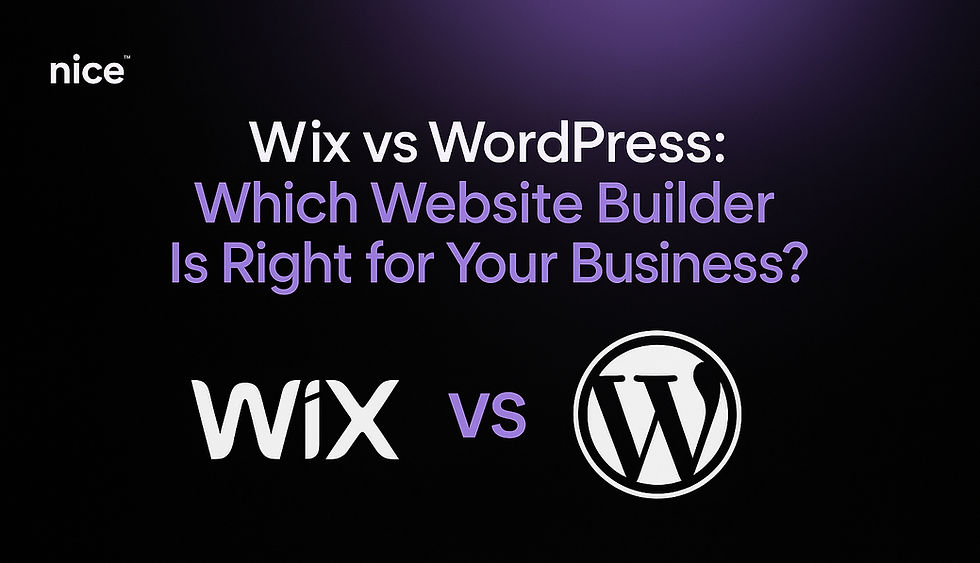The Key to Modern Website Responsiveness
- Mykyta Rudnyk

- Feb 19, 2024
- 4 min read
With mobile devices accounting for 58.21% of global internet traffic, the emphasis on designing websites that are as functional and visually appealing on a smartphone as they are on a desktop has never been more critical. Responsive web design ensures that your site provides an optimal viewing experience—easy reading and navigation with a minimum of resizing, panning, and scrolling—across a wide range of devices. This guide delves into the nuances of creating fully responsive websites, embodying Nice Digital Studio's expertise in the domain.

The Problems Responsive Design Solves
Responsive design addresses the challenge of creating websites that provide an optimal viewing experience across a wide range of devices. It eliminates the need for separate versions of a website, simplifying content management and improving SEO.

Making Your Website Fully Responsive
Achieving a fully responsive website involves several key strategies, from adopting a mobile-first approach to optimising images.
How do I make my website fully responsive?
It begins with a mobile-first approach, employing flexible grid layouts that use percentages rather than pixels, using media queries to apply different styles for different devices, and optimising images to scale appropriately. Incorporating responsive design fonts and images that adapt without losing quality is crucial. CSS media queries play a significant role in applying different styles for different devices, ensuring a nice and consistent experience across all platforms.
The Ideal Size for Responsive Design
There is no one-size-fits-all answer to the best size for responsive design. However, designing for a range of screen sizes, from 320px for smartphones to 1920px for large desktops, ensures broader compatibility. Responsive website breakpoints—where the website's layout changes to accommodate different devices—are typically set at 320px, 768px (tablets), and 1024px (desktops), offering a good starting point.
Foundations of Responsive Design
At the heart of responsive web design are its foundational elements and principles.
The Three Main Elements of Responsive Design
Responsive web design rests on three pillars: flexible layouts, media queries, and responsive media. These elements work together to ensure that a website responds smoothly to the varying screen sizes and resolutions, providing a seamless user experience.
The Four Basic Elements of Design
Understanding the four basic elements of design—colour, shape, space, and texture—is essential in responsive design. These elements influence the visual appeal and usability of a website, making it more engaging and accessible to users across different devices.
Best Practices and Key Considerations
Responsive design also includes following best practices that enhance usability and aesthetics.
The Best Responsive Design Practices
The best responsive designs prioritise simplicity, usability, and speed. They feature flexible, grid-based layouts, optimised images, and typography that remains legible and attractive across devices. The use of media queries to apply appropriate styles for different devices is also a hallmark of effective responsive design. The best responsive design combines innovation, usability, and aesthetics, creating websites that not only look great on any device but also enhance the user experience regardless of device.
The Key to All Responsive Design
Flexibility is the key to responsive design—focusing on creating web experiences that are functional and satisfying on mobile devices as well as on desktop computers. This approach ensures that web content fluidly adjusts to various screen sizes, offering an optimal viewing experience. Embracing a mobile-first strategy often leads to more efficient and effective responsive designs.
Challenges and Solutions in Responsive Design
Responsive web design comes with its set of challenges, from dealing with a variety of devices to balancing design and functionality.
Common Responsive Design Patterns
Responsive design patterns, such as fluid grids, flexible images, and media queries, are commonly used to address different design challenges. Other patterns include off-canvas menus and modular layouts that reconfigure to fit various screen sizes, enhancing the user experience.
Why Responsive Web Design Can Be Challenging
Responsive web design is complex due to the variety of devices and screen sizes. It is also challenging due to the need to balance design and functionality, understand user behaviour across devices, and implement responsive features effectively. Designers must anticipate and test for numerous scenarios, ensuring the website remains functional and visually appealing across all potential user environments.
Impact on User Experience and SEO
The impact of responsive design extends beyond aesthetics, significantly affecting user experience and SEO.
Responsive Design in UX
Responsive design plays a crucial role in user experience (UX) by ensuring that users have a positive interaction with the website, regardless of the device they use. It focuses on adaptability, usability, and satisfaction in a multi-device world.
Crafting Responsive UI Design
Responsive UI design focuses on flexibility and adaptability. Use scalable vector graphics (SVGs) for elements that need to scale without losing quality. Implement touch-friendly interfaces for smaller screens, and consider the accessibility of your design, ensuring it's navigable and readable on any device.
Google's Preference for Responsive Design
Google prefers responsive design, ranking responsive websites higher in search results due to their better user experience, especially on mobile devices, aligning with Google's mobile-first indexing. Moreover, it reduces the likelihood of SEO issues related to duplicate content. Responsive websites also align with Google's mobile-first indexing, emphasising the importance of mobile-friendly web design.
The SEO Benefits of Responsive Design
Responsive design significantly enhances SEO by improving the usability of the site, decreasing bounce rates, and ensuring consistent content across devices. Google’s preference for responsive websites further underscores its importance for search engine optimization.
Our Commitment at Nice Digital Studio
At Nice Digital Studio, we place immense value on the responsiveness of websites. We understand its critical importance in today's crowded digital landscape, which is why we ensure that every project we undertake is optimised for the best possible user experience across all devices. Our recognition among the top responsive web design companies by Design Rush Website reflects our commitment to excellence in responsive web design.





Comments